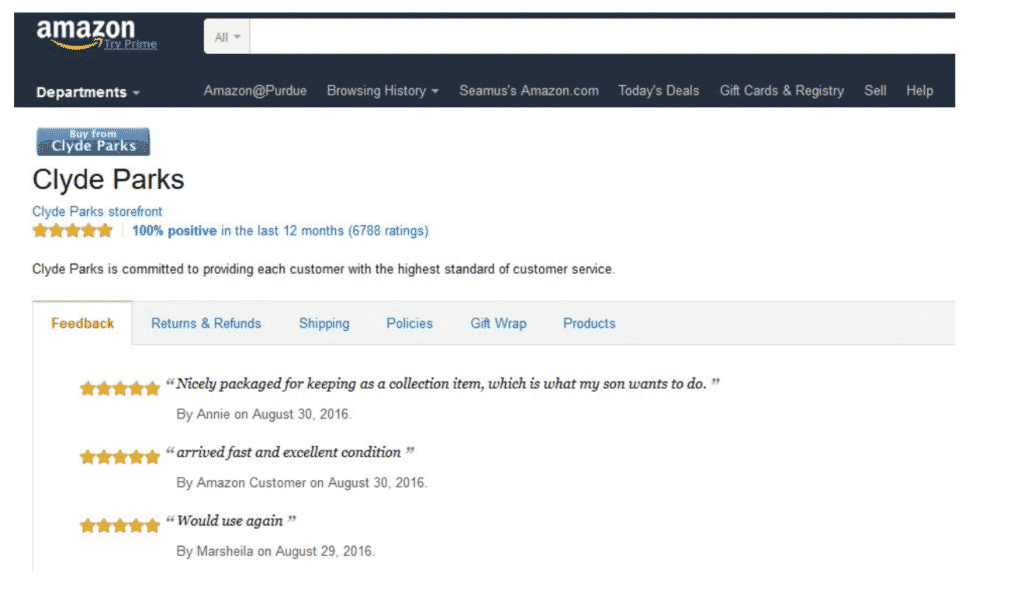Why Is Feedback So Important for Amazon Sellers?
Customer feedback for products and sellers is hugely important on Amazon because Amazon’s vision is to be “earth’s most customer-centric company, where customers can find and discover anything they might want to buy online.” Their mission statement revolves around one thing that has always been important to them—the customer. Amazon uses its seller feedback rating to see if third-party sellers are reaching the high standards of customer service it expects. Amazon calculates your feedback rating based on the feedback received from its customers over the last 12 months. If you have aspirations of winning a share of the Buy Box (and who doesn’t?!) then you need to maintain a feedback rating of over 95% and ideally over 98%.Compare these two sellers. Who is more likely to win the sale or the Buy Box?

Seller B is doing reasonably well but Seller A is knocking it out of the park with a 100% feedback rating. Seller A is therefore seen as more trustworthy by Amazon and the customer. Your feedback rating provides social proof that you can be relied upon to deliver an outstanding customer experience (or not).
Amazon’s Feedback Guidelines
We strongly recommend that all third-party sellers become familiar with Amazon’s feedback guidelines. Here’s a quick summary of Amazon’s Feedback Guidelines:- Asking for reviews is allowed and is encouraged by Amazon.
- Offering incentives or asking for positive reviews is not allowed! If you do this, you’re very likely to have your seller privileges revoked. So, our advice is—don’t do it!
The Difference Between Product Reviews and Seller Reviews
When you search for a product on Amazon, you’ll notice a gold star rating and a number indicating how many product reviews it has received. Product reviews are particularly important for private label sellers. Gaining 4 and 5-star reviews will improve your product visibility and sales on Amazon. High marks from high-volume buyers will improve visibility and sales even more. LOL: Here’s a funny Amazon product review about a t-shirt with three wolves on it which you can buy here if you’re so inclined!
Reviews for specific Amazon sellers (rather than for products) are a bit more difficult to find. Here’s an example directly from Amazon for a seller who’s winning at customer service. You’ll notice they’ve received 6,788 reviews in total and have a perfect feedback rating of 100% over the last 12 months.

Amazon allows customers to leave a review for both products and sellers. You will likely want to direct them toward product reviews that increase your Buy Box visibility on a specific item you’re selling.
How to Get More Positive Amazon Feedback
There are a lot of ways for Amazon sellers to get more positive feedback on Amazon. At the core are product quality/design, fast shipping, and solid customer service in case of defects or shipping problems. Below, we touch on these basics and discuss a whole lot more you can do to increase positive feedback and ultimately garner hundreds of 5-star reviews for your products.Use proven digital marketing strategies to promote your products
You’re limited in how you market your product on Amazon. Sure, you can show-off the features, but your listing lives in Amazon’s marketplace environment. Using a landing page as an intermediate page between your advertisement and your Amazon product listing can offer more information in a more appealing format. Plus, you can use a landing page to gather information from customers that Amazon doesn’t share with you as a seller. This can give you another point of entry to seek feedback, like social media, as well as market your products. It’s statistically proven that the chances of conversion on Amazon are higher with customers that visit your landing page than those who only look at your Amazon listing.Sell a good product
It’s easy to reel in good reviews when your product and shipping speed knocks your customers socks off. Not every product is going to be a hit and you’ll inevitably deal with some defective products. Make sure you’re offering the right prices; customers will give you a break on quality if you give them a break on cost. Be sure to deal with defective products swiftly and you’ll be rewarded with good reviews (and an absence of bad ones denouncing your products).Get it to customers quickly
When it comes to shipping, you want to fulfill your promises. If you advertise two-day delivery on your listings, make sure to deliver within that time. If something goes wrong, communicate that to the customer as soon as possible. Use special packaging to protect fragile items. Make your customers feel special by giving them top-notch packaging. This will give them a feeling of bliss even if the product they’ve bought from you is not so high end. You can also include an insert that promotes your brand and asks for a review. Pro-Tip: Product inserts are a simple, yet efficient way for sellers to get reviews from Amazon customers. They are a relatively cheap way to appeal for reviews. They can also promote your brand and even provide instructions on how to use your product. A simple manual can also reduce the risk of bad reviews. Any and all of the above will help you improve your feedback on Amazon. Like everything else there are dos and don’ts to follow when deciding on copy for your product inserts. Amazon has a detailed Selling Policies and Seller Code of Conduct that all sellers must adhere to on inserts.Provide quality customer service
From questions to troubleshooting issues, customer service is paramount to your business’s success. A great way to ensure top-notch customer service is to provide the information your customers need before they ask. This can include offering a frequently asked questions (FAQ) section on your site, or product pages with links to relevant information. On your site , you can also include infographics, how-to video guides, and more to help provide essential information to your customers. Some of this content might also be good to share on social media, where product care tips and product hacks are a great way of keeping customers engaged. Lastly, live chat support enables you to reach customers in real time as issues or inquiries arise, saving them time and, potentially, your sales. You can also ask for instant feedback once an issue has been resolved.Be proactive about asking for feedback
The most obvious way to get more feedback is…to ask for it (at the right times and in the right way—you don’t want to overload a customer and send them running to a competitor). You can do this through Amazon SellerCentral’s “Request a Review” feature on each individual order between 4 and 30 days after the order’s delivery date. Click the button within your order to trigger an email sent by Amazon soliciting a review from your customer about your product. Services like FeedbackFive and FeedbackWhiz can automate this process for your business on a bulk scale with the ultimate goal of improving your feedback and reviews. Amazon has started automating more and more of the review process for sellers. They will send out the emails to your customers but you don’t have many ways to customize those messages. You can include:- Your logo (make sure to include this)
- A custom message to your customer
Use Amazon Vine Program to get early feedback for products
Amazon’s Vine Program is an invite-only group of reviewers that receive products for free in exchange for impartial reviews. They will often receive products before they are released. Anyone who is a member of the Vine Program will have a badge on all the reviews they leave as Amazon distinguishes them as Vine Voices. Amazon banned all forms of incentivized reviews, whether paying customers for reviews or sending free products to customers to review. The only legit way to get early reviews is to enroll in the Amazon Vine Program.Things NOT To Do To Improve Your Amazon Feedback
DO NOT: Use Fake or Zombie Accounts
Fake accounts (zombie accounts that are not used by real customers) are used by Amazon sellers to purchase their own products and leave positive reviews. If you do this, chances are you will be found by Amazon’s constant ever-changing algorithms which are being significantly improved over time.DO NOT: Lean Hard on Friends and Family
Friends and family can only write reviews if they buy the product. Amazon closely monitors the IP address, credit card billing info, and shipping addresses of customers. Why? To make sure your reviews are unbiased and written by real customers, not accumulated from your loved ones. Amazon’s terms and conditions are strictly against getting reviewed this way.DO NOT: Seek Out Customer Data in Amazon Shipment Reports
By collecting a customer’s address and looking them up in big data databases, chances are you can track their email and market to your customers via social media. This is totally against Amazon’s rules.RISKY: Review Trading Websites, Facebook Groups, and Forums
One of the other ways to try and stack up reviews is by using websites that offer Amazon deals. However, this is quite risky. These sites might seem like an effective way of acquiring reviews fast, but you also run the risk of acquiring lots of negative reviews. While it’s perfectly fine to promote a product in large forums, DO NOT incentivize for reviews.How to Deal with Negative Seller Feedback
If you sell on Amazon, it’s somewhat inevitable that you’ll get a negative review. It happens to all sellers even top-rated ones. When it happens, don’t ignore it,as even a handful of bad reviews can affect your Amazon business. One thing to note, Amazon’s feedback isn’t set in stone. An unsatisfied customer can update or remove their seller feedback for 60 days after they leave their review. Therefore, if you receive a disappointing review, work with the customer to see if there’s any way you can improve their experience and satisfaction levels. Now, let’s look at the three main ways you can deal with a negative review on Amazon:1. Get Amazon to remove it
In the very first instance, check to see if the feedback complies with Amazon’s guidelines—if it doesn’t, they’ll remove it. The effort required by this is low because all you have to do is send a message to Amazon via Seller Central stating the reason why you think the feedback infringes their guidelines. Here’s an example of a message you might send: “I’ve received a comment from [buyer’s name] on [order number] and feel it is more suited to the product reviews section. Can you remove this from my feedback profile? Here is the comment in question, [insert comment].” Amazon will remove negative feedback if:- The feedback includes obscene language.
- The feedback includes personally identifiable information.
- The entire feedback comment is a product review.
- The entire feedback comment is regarding fulfillment or customer service for an order Fulfilled by Amazon (FBA).
2. Get the customer to revise or remove their feedback
For this method, you’ll need to communicate with your buyer about any misunderstandings. Email them and ask exactly what they weren’t happy with, and try and clear up any issues they may have. It’s going to take a lot of effort to make yourself readily available to just one buyer, and focus a lot of energy for just one review. But it’s worth it! If you can bump up your feedback score and keep your reputation stellar.3. Respond to the negative feedback
Okay, so maybe the first two strategies didn’t work and what you’re left with is damage limitation. It’s like how on TripAdvisor you might come across a review from a disgruntled customer only for the restaurant manager to respond, addressing the person’s concerns. You won’t be able to remove the negative feedback, but at least you’ve got an opportunity to explain your side of the story. Sometimes it’s necessary to take one on the chin and move on—the important thing is that you addressed the issue (if there was one) in a professional manner. With time, the feedback will fall off the first page and after 12 months, it won’t count towards your seller feedback rating. Just make sure that 95% of the feedback you receive is positive—in other words, you need to get 19 positive reviews for every one bad one. Seller Tip: One thing that many sellers don’t realize is that 3-star or neutral feedback can be harmful to your seller rating—so, treat this in the same way you would a 1-star or 2-star review (using the strategies detailed above).The Value of Negative Feedback
Can negative feedback actually be good for your business? It can as long as the majority of reviews remain positive. For example, negative feedback could result in you making changes to the selling process and improve the customer experience for future buyers. Also, a study undertaken by Reevoo revealed 95% of customers suspect fake or censored reviews when bad scores aren’t present. So, a bad review could actually be beneficial by making your business appear more credible.Conclusion
Getting product reviews and improving your overall feedback on Amazon can take a long time. But as Michael LeBoeuf once said, “A satisfied customer is the best business strategy of all.” If you can create happy customers then you’ve accomplished a major part of selling on Amazon. The key to creating to happy customers, in short, are:- Delivering a high quality product on time with packaging that promotes your brand and product as well as a manual or short guide
- Using landing pages and other digital marketing to promote your product and provide helpful content to customers.
- Provide great customer service, answering questions even pre-sale, issuing refunds and product replacements promptly, and being accessible to the customer.
- Ask for feedback by using Amazon’s built-in tools and reach out to your customers in other ways, like via social media groups, to solicit feedback from happy customers.



